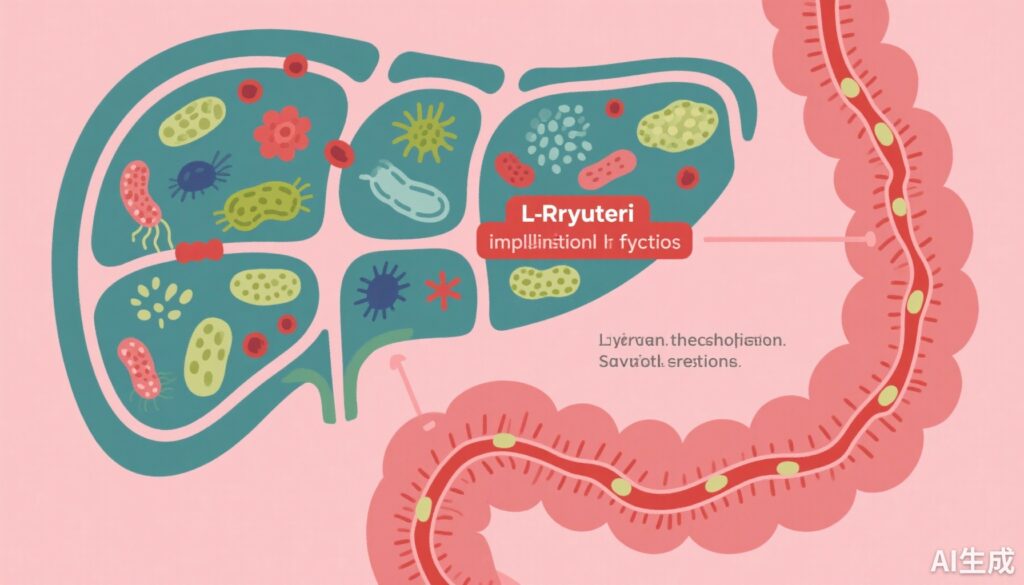Introduction
Transarterial chemoembolization (TACE) remains a pivotal treatment modality for patients with unresectable hepatocellular carcinoma (HCC). While effective in tumor management, TACE’s clinical utility is often hampered by its main complication: post-procedural liver injury (TACE-LI). This complication significantly affects long-term outcomes, recurrence rates, and overall survival.
Historically, TACE-induced liver damage was attributed primarily to ischemic necrosis and localized cytotoxic effects. However, recent advances reveal complex underlying mechanisms, including immune responses and, crucially, the role of gut microbiota. This article discusses emerging evidence linking gut microbiota disturbances, specifically the reduction of Limosilactobacillus reuteri (L. reuteri) and its metabolite indole-3-lactic acid (ILA), to the severity of TACE-LI.
Study Background and Disease Burden
Hepatocellular carcinoma is the sixth most common cancer worldwide, with a high mortality rate largely due to late diagnosis and limited curative options. TACE offers a minimally invasive palliative treatment for unresectable HCC but is associated with considerable liver injury, which limits its benefits.
Liver injury post-TACE manifests through inflammatory cascades, hepatocyte apoptosis, and fibrosis, exacerbating liver dysfunction. Despite recognizing these effects, the precise biological and microbiological pathways influencing TACE-LI have remained elusive, emphasizing the need for novel therapeutic strategies.
Methodological Approaches
The referenced study employed a multifaceted approach including:
– Microbial multi-omics analysis to profile gut microbiota changes post-TACE;
– Animal models using antibiotics to deplete gut microbiota and fecal transplants from TACE-treated rats or HCC patients;
– Administration of live L. reuteri or ILA to evaluate protective effects;
– Transcriptomics and molecular biology techniques to dissect mechanistic pathways.
This comprehensive methodology allowed a robust investigation of the microbiota-host interactions affecting liver injury.
Key Findings and Results
The study yielded several critical insights:
– Rats subjected to microbiota depletion via antibiotics exhibited more severe TACE-LI, indicating a protective role of gut microbiota.
– Fecal transplants from HCC patients or TACE-treated rats transferred susceptibility to worse liver injury, confirming microbiota involvement.
– L. reuteri abundance was significantly reduced in both rats after TACE and patients with HCC, correlating with severity.
– Reduced L. reuteri led to decreased levels of ILA, a tryptophan metabolite with anti-inflammatory properties.
– Supplementation with live L. reuteri or ILA mitigated liver injury by suppressing inflammation.
– Mechanistically, L. reuteri used its enzyme phenyllactate dehydrogenase (fldH) to produce ILA, which exerted protective effects by inhibiting HSP90 ATPase activity, thereby deactivating the NLRP3 inflammasome in macrophages.
– Clinically, lower L. reuteri and ILA levels correlated with worse liver injury outcomes and poorer overall survival in HCC patients.
These findings establish a causal link between microbiota dysbiosis, decreased ILA production, inflammation amplification, and TACE-LI.
Expert Commentary
This research pioneers understanding of microbiota-mediated pathways in post-interventional liver injury, identifying a novel mechanistic axis involving L. reuteri and ILA. The bidirectional influence between gut microbes and hepatic immune responses underscores the potential of microbiota-targeted therapies.
Limitations include the translational gap from animal models to human application, the complexity of microbiota-host interactions, and potential variability among patients. Nonetheless, the findings open avenues for clinical trials evaluating probiotics or ILA supplementation as adjuncts to TACE.
From a biological standpoint, the suppression of NLRP3 inflammasome activation through microbial metabolites presents an exciting target for mitigating liver injury not only in HCC but potentially in other hepatic diseases.
Conclusion and Future Perspectives
This pioneering study elucidates how TACE-induced gut microbiota disturbances, specifically the decline in L. reuteri and ILA, exacerbate liver injury via immune activation pathways. Restoring these microbial constituents or their metabolites offers promising therapeutic strategies to reduce TACE-associated liver injury.
Further clinical trials are warranted to evaluate safety, dosing, and efficacy of microbiota-based interventions. Ultimately, integrating microbiota management with existing therapies could significantly improve outcomes for patients with unresectable HCC.
Funding and ClinicalTrials.gov
Not specified.
References
Li R, Liu J, Ye F, He S, Huang J, Zhou M, Xie Q, Liu Z, Cheng W, Wang G, Deng W, Wang X, Yang T, Liang Z, Hu F, Huang W, Cai M, Xie L, Zhang W, Gong S, Chen Y, Wang Y, Lin L, Zhu K. Microbial metabolism dysfunction induced by transarterial chemoembolization aggravates postprocedural liver injury in HCC. J Hepatol. 2025 Oct 17;S0168-8278(25)02557-7. doi: 10.1016/j.jhep.2025.10.008. PMID: 41110523.
AI Image Prompt: “A detailed scientific diagram illustrating gut microbiota interactions with liver tissues, emphasizing Limosilactobacillus reuteri, indole-3-lactic acid, immune cells, and inflammatory pathways in the context of post-TACE liver injury”.



